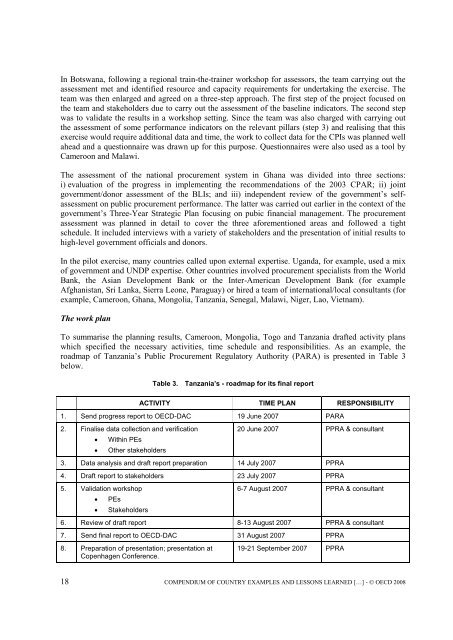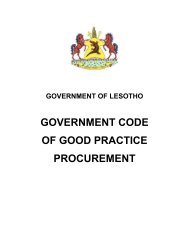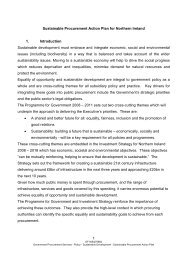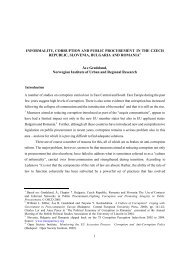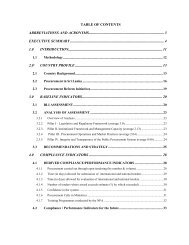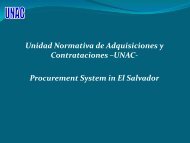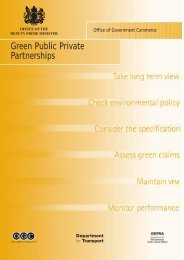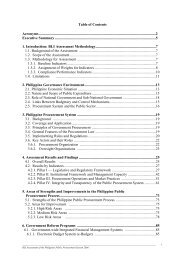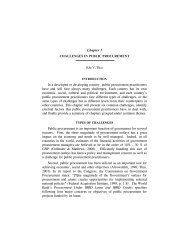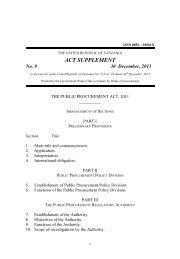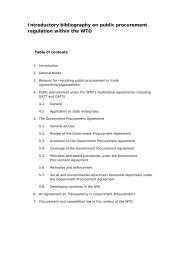Compendium of Country Examples and Lessons Learned from ...
Compendium of Country Examples and Lessons Learned from ...
Compendium of Country Examples and Lessons Learned from ...
You also want an ePaper? Increase the reach of your titles
YUMPU automatically turns print PDFs into web optimized ePapers that Google loves.
In Botswana, following a regional train-the-trainer workshop for assessors, the team carrying out theassessment met <strong>and</strong> identified resource <strong>and</strong> capacity requirements for undertaking the exercise. Theteam was then enlarged <strong>and</strong> agreed on a three-step approach. The first step <strong>of</strong> the project focused onthe team <strong>and</strong> stakeholders due to carry out the assessment <strong>of</strong> the baseline indicators. The second stepwas to validate the results in a workshop setting. Since the team was also charged with carrying outthe assessment <strong>of</strong> some performance indicators on the relevant pillars (step 3) <strong>and</strong> realising that thisexercise would require additional data <strong>and</strong> time, the work to collect data for the CPIs was planned wellahead <strong>and</strong> a questionnaire was drawn up for this purpose. Questionnaires were also used as a tool byCameroon <strong>and</strong> Malawi.The assessment <strong>of</strong> the national procurement system in Ghana was divided into three sections:i) evaluation <strong>of</strong> the progress in implementing the recommendations <strong>of</strong> the 2003 CPAR; ii) jointgovernment/donor assessment <strong>of</strong> the BLIs; <strong>and</strong> iii) independent review <strong>of</strong> the government‟s selfassessmenton public procurement performance. The latter was carried out earlier in the context <strong>of</strong> thegovernment‟s Three-Year Strategic Plan focusing on pubic financial management. The procurementassessment was planned in detail to cover the three aforementioned areas <strong>and</strong> followed a tightschedule. It included interviews with a variety <strong>of</strong> stakeholders <strong>and</strong> the presentation <strong>of</strong> initial results tohigh-level government <strong>of</strong>ficials <strong>and</strong> donors.In the pilot exercise, many countries called upon external expertise. Ug<strong>and</strong>a, for example, used a mix<strong>of</strong> government <strong>and</strong> UNDP expertise. Other countries involved procurement specialists <strong>from</strong> the WorldBank, the Asian Development Bank or the Inter-American Development Bank (for exampleAfghanistan, Sri Lanka, Sierra Leone, Paraguay) or hired a team <strong>of</strong> international/local consultants (forexample, Cameroon, Ghana, Mongolia, Tanzania, Senegal, Malawi, Niger, Lao, Vietnam).The work planTo summarise the planning results, Cameroon, Mongolia, Togo <strong>and</strong> Tanzania drafted activity planswhich specified the necessary activities, time schedule <strong>and</strong> responsibilities. As an example, theroadmap <strong>of</strong> Tanzania‟s Public Procurement Regulatory Authority (PARA) is presented in Table 3below.Table 3. Tanzania’s - roadmap for its final reportACTIVITY TIME PLAN RESPONSIBILITY1. Send progress report to OECD-DAC 19 June 2007 PARA2. Finalise data collection <strong>and</strong> verificationWithin PEsOther stakeholders20 June 2007 PPRA & consultant3. Data analysis <strong>and</strong> draft report preparation 14 July 2007 PPRA4. Draft report to stakeholders 23 July 2007 PPRA5. Validation workshopPEsStakeholders6-7 August 2007 PPRA & consultant6. Review <strong>of</strong> draft report 8-13 August 2007 PPRA & consultant7. Send final report to OECD-DAC 31 August 2007 PPRA8. Preparation <strong>of</strong> presentation; presentation atCopenhagen Conference.19-21 September 2007 PPRA18 COMPENDIUM OF COUNTRY EXAMPLES AND LESSONS LEARNED […] - OECD 2008


